Modern galleries, elegant hotels in the city built along the Río de la Plata
By Lucy Komisar
The citizens of Buenos Aires are called “porteleños,” people of the port. Perhaps this connection to the rest of the world contributes to their sophistication. “BA” is a city of grand, classical-style buildings, elegant neighborhoods, scruffy crowded “barrios,” pedestrian malls and even a kitchy tourist waterfront along the Ro de la Plata, the Platt River. Like other great cities, it‘s a center of contemporary art. Much of that reflects its turbulent political history.
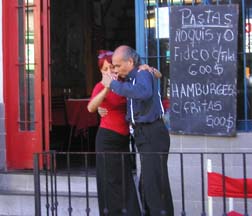
One day, I headed to La Boca, a collection of cafes, shops and galleries at a section of the huge harbor that cuts a swath across the north and east of the city. The cafes have sultry tango dancers to draw diners, but this is a real neighborhood influenced by the European, mostly Italian, immigration of the late 1800s.
It was a birthplace of the tango – its music a fusion of the rhythms of African slaves, the tunes of Southern Italy and Spain, and the local “milonga.” The dance started in brothels and then was popularized, remaining with its origins always a bit scandalous. You can see that history reflected in the now fading murals painted on building walls of the side streets.
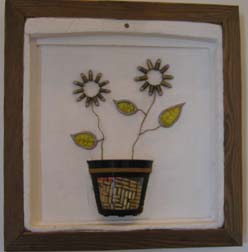
When I visit a city, I explore the contemporary galleries or museums to see what the local artists are doing. The Proa Fundación space at La Boca is for contemporary artists not chosen by the big museums or galleries; it has a strong interest in political art.
The exhibit I saw showed works based on Argentina‘s wrenching experience of the 1970s, when the country was violated by a repressive junta. Some of the art works were crafted from of the dictators‘ victims. Polo Tiseira‘s collages of plants, which represent life, were ironically fashioned with bullets, which represent death.
If you happen to be in BA on a Friday afternoon, stop by the city-supported Centro Cultural Recoleta in the midst of a small park crisscrossed by rows of artisans selling wool shawls, handbags, jewelry and other crafts.
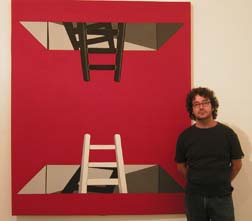
The cultural center has numerous galleries, and if you‘re lucky, you might be there for a opening; most of them occur on Friday afternoons. I arrived by chance in time to quaff some Argentine wine in honor of painter Alejandro Gigli, who was showing his art. Political art? In another gallery, I found a work composed of racks of dolls reflecting the merchandising of women.
One political gallery turned up in an unexpected place. Strolling over to see the Casa Rosada, the pink presidential palace with its gray French-style Mansard roof, I came upon the storefront café and bookstore of the Mothers of the Plaza de Mayo, with their signature white kerchief. The Casa
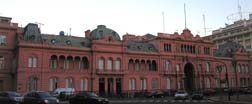
Rosada broods over that famous, politically-charged square, and the “Mothers,” no less famous now, have held a demonstration every Thursday calling for justice to prosecute the military killers of their activist children in Argentina‘s dirty war, 1976-1983.
Argentina has come a long way since then. The government has granted the “Mothers” concession booths at the Plaza, and they are mentioned in
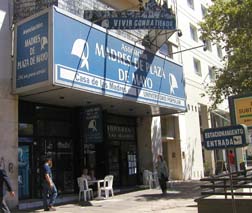
official guides. The café-bookstore is a tourist attraction! In this vibrant city, politics and culture mix with a Latin passion.
Before you leave the plaza, visit the Cabildo, built in 1748 and the hotbed of the May 1810 revolution which started the country on the way to independence from Spain. Politics and art are sometimes uneasy partners.
The famous English Tower, which evokes Big Ben, was given to Argentina by the British to commemorate the May revolution and set in Plaza San Martin, named after the independence leader.
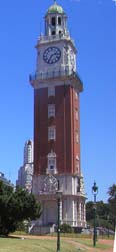
It is still firmly planted in this central square in spite of the 1982 war between Argentina and Britain over the Malvinas Islands (Falklands, to the British), a conflict which ironically benefited the Argentine losers, because it forced out the military dictators. Still, the Argentines changed the name from the Torre de los Ingleses (the English Tower) to the Monumental Tower.
How appropriate, as I was experiencing a city steeped in politics, to be staying at the Sheraton Park Tower just across from the English clock tower. When I arrived at the Sheraton, there was a red carpet set out and a gaggle of people – with welcoming placards — waiting for the President of Venezuela. Hugo Chavez had picked the same digs!
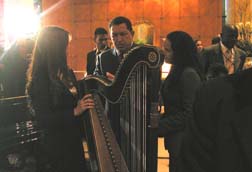
No wonder. The Park Tower is elegant, regal, with marble in hallways and rooms, even in the elevator. Bathroom fixtures are gold and silver. My bedroom had French furnishings; the hallway was decorated with Chinese vases. In the lobby lounge, you could fold yourself into well-stuffed chairs set among potted palms and listen to a piano player or harpist. Chavez liked the harpist and spent time chatting with her. Then he went around glad-handing everyone, including this writer, as if he were Bill Clinton. The Sheraton Park Tower is very popular with heads of state!
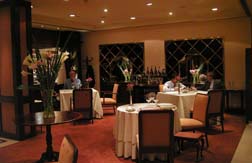
The breakfast room is under a sunroof, and the buffet “do you want caviar on your croissants?” Plus tropical fruits, and the usual fish, pastries, cereals, yogurts. Lunch at the El Aljibe restaurant is where you go for thick and tender steaks from the Pampas; would you believe that steak cost $13? I accompanied the tender beef with salad greens of varieties I‘d not seen before. El Aljibe also features deer filet marinated in Malbec wine with almonds, pumpkin and honey! I drank the excellent Malbec red. On the walls of the restaurant are paintings of peasants and other scenes reflecting the country.
Adjoining the Park Tower is the larger “sister” Sheraton, which has a convention center (where Chavez held his press conference), a health club with sauna and massage rooms, and a swimming pool.
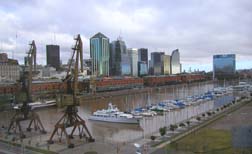
The port again: for “porteros,” waterlinks are key. Puerto Madero, an area at the eastern edge of the city center, was developed beginning in 1991 to incorporate the port to the city. It used to have working cargo docks; now a few old loading cranes are tourist attractions – one an information center!
The Hilton Hotel, part of the new Puerto Madero, sits smartly overlooking the canal, which now has docks for yachts. I could see the canal and boats from my Hilton picture window. Lines of outdoor cafes and shops inhabit the refurbished red brick canal warehouses. As dusk falls, you can see the lights go on in the restaurants along the water and on some of the larger craft anchored there.
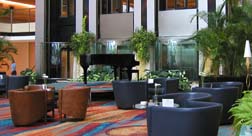
The hotel is nine floors around an atrium topped with a sun roof through which pours abundant light; in the evening a lobby pianist holds forth. The rooms are soft modern, the furniture dark wood and glass, the beige walls hung with artistic of the city. And like all Hiltons, the generous desk has every accoutrement a business traveler could want. Guests even get complimentary cell phones: incoming calls are free; you pay only for calls you make.
Walking away from the canal on the other side of the hotel, you find a nature reserve built around five lakes and several jogging paths. The hotel offers a map of suggested routes from 2 to 4.5 miles distance. There‘s also a Hilton fitness center, pool, steam rooms and massage center.
A sense of history pervades Buenos Aires, but it is also, today, a very modern city at the center of a vibrant, democratic Argentina. Its politics, fortunately, have caught up with its art.
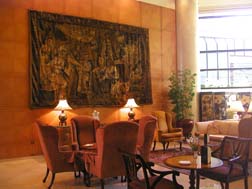
Sheraton Park Tower
Avenida Leandro N. Alem 1193
(1001) Buenos Aires, Argentina
Tel: 54 (11) 4318-9100
Fax: 54 (11) 4318-9150
From the U.S. 800 325-3589
http://www.starwood.com/buenosaires
Hilton Hotel
Avenida Macacha Güemes 351
C1106BKG Puerto Madero
Buenos Aires, Argentina
Tel 54 (11) 4891-0000
Fax 54 (11) 4891-0001
From the U.S. 800-HILTONS
http://www.hilton.com
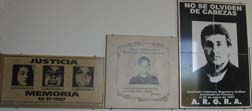
Proa Fundación
Av. Pedro de Mondoza 1929
La Boca, Buenos Aires
Tel 54 (11) 4303-0909
http://www.proa.org
in**@pr**.org
Tues-Fri, 12 to 7, Sat & Sun 11 to 7.
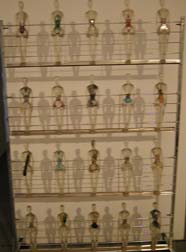
Centro Cultural Recoleta|
Junin 1930
Buenos Aires
Tel 54 (11) 4803-1040
http://www.centroculturalrecoleta.org
Asociación Madres de Plaza de Mayo
Hipolito Yrigoyen 1584
Buenos Aires
Tel 54 (11) 4383-0377/6430
http://www.madres.sorg
ma****@sa*****.com


Just watched a movie last night with R. Duvall- Assassination Tango- which takes place in BA. I woke up thinking about Argentina, and then I came upon this review. It sounds fabulous, and I must go someday, soon I hope. Great web-site. I enjoy your interviews with Dave Emory on the radio here in the Bay Area.
hola lucy, que gusto encontrar esta nota, soy Polo, AUTOR DE FLOR DE BALA , gracias
(translation: hello lucy, I am pleased to find this note, I am Polo, creator of the BULLET FLOWER, thanks)